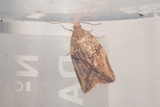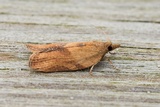Epiphyas postvittana (Walker, 1863) Species
Last modified: Sept. 24, 2025, 3:17 p.m.
A new species for Belgium in 2014 (WV). Hitherto known from 3 provinces.
Details
- Classification
- Family: Tortricidae > Subfamily: Tortricinae > Tribus: Archipini > Genus: Epiphyas > Species: Epiphyas postvittana
- Vernacular names
- Australische bladroller (NL), Light Brown Apple Moth (EN), Australischer Apfelwickler (DE)
- First mention in Belgium
- De Prins W. 2016. Catalogus van de Belgische Lepidoptera – Catalogue of the Lepidoptera of Belgium. — Entomobrochure 9: 1–279. On page 119.
- Status
-
Naturalised
Distribution
Imago
Wingspan 16–25 mm. Forewings of both sexes are light brown to pale yellow with brown to dark-brown markings. Males are more variable than females, although in most males the basal half of the forewing is lightly marked, the median fascia is well defined, and there is a dark mark on the costa distal to the median fascia.
The female forewing color is more uniform, with a poorly defined median fascia and an overall mottled or speckled appearance. Most females have a dark mark on the dorsum of each forewing and two dark spots on the posterior of the thorax.
Egg
The eggs are laid in masses on smooth surfaces of host plant foliage, including leaves, stems, and fruit.
Bionomics
Young larvae feed on the undersides of leaves within a silk chamber. Older larvae may fold individual leaves, create a nest of several leaves webbed together, or web leaves to fruit and feed on the surface of the fruit. Larvae on deciduous trees and shrubs feed as long as leaves remain on the food plant and then fall down to the ground, where they may feed on understory vegetation or survive in leaf litter.
This species can be a pest species in orchards. The adults come to light.
Flight periods
It flies in two generations between May and mid-November. Can also be found indoors all year round.
Observed on
- Substrates:
- Polyphagous
It lives very polyphagously on a range of plants like Malus, Pyrus, Vitis, Citrus, Diospyros, Actinidia, Rubus, Fragaria, Vaccinium, Ribes, Persea Azara serrata, Camillia, Ceanothus, Drimys, Embothrium coccineum var. longifolium, Euonymus japonica, Laurus nobilis, Lonicera, Olearia, Leptospermum scoparium, Phygelius, Pittosporum, Pyracantha, Rhododendron, Skimmia japonica and many others...


